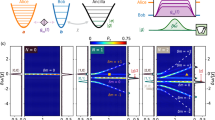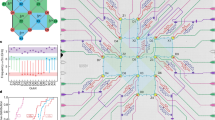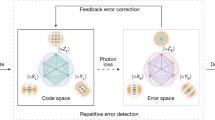Abstract
A critical challenge in developing scalable quantum systems is correcting the accumulation of errors while performing operations and measurements. It is known that systems where dominant errors can be detected and converted into erasures have relaxed requirements for quantum error correction. Recently, it has been proposed that this can be achieved using a dual-rail encoding of quantum information in the microwave photon states of two superconducting cavities. One necessary step to realize this erasure qubit is to demonstrate a measurement and to flag errors as erasures. In this work, we demonstrate a projective logical measurement of a dual-rail cavity qubit with integrated erasure detection and measure the qubit idling errors. We measure the logical state preparation and measurement errors at the 0.01% level and detect over 99% of the cavity decay events as erasures. We use the precision of this measurement protocol to distinguish different types of error in this system, finding that although decay errors occur with a probability of approximately 0.2% per microsecond, phase errors occur 6 times less frequently and bit flips occur at least 150 times less frequently. These findings represent a confirmation of the expected error hierarchy necessary to concatenate dual-rail cavity qubits into a highly efficient erasure code.
This is a preview of subscription content, access via your institution
Access options
Access Nature and 54 other Nature Portfolio journals
Get Nature+, our best-value online-access subscription
$32.99 / 30 days
cancel any time
Subscribe to this journal
Receive 12 print issues and online access
$259.00 per year
only $21.58 per issue
Buy this article
- Purchase on SpringerLink
- Instant access to full article PDF
Prices may be subject to local taxes which are calculated during checkout




Similar content being viewed by others
Data availability
The datasets generated and analysed during this study are available via Zenodo at https://doi.org/10.5281/zenodo.11099521 (ref. 57).
Code availability
The code that supports the findings of this study is available from the corresponding authors upon reasonable request.
References
Mirrahimi, M. et al. Dynamically protected cat-qubits: a new paradigm for universal quantum computation. New J. Phys. 16, 045014 (2014).
Michael, M. H. et al. New class of quantum error-correcting codes for a bosonic mode. Phys. Rev. X 6, 031006 (2016).
Joshi, A., Noh, K. & Gao, Y. Y. Quantum information processing with bosonic qubits in circuit QED. Quantum Sci. Technol. 6, 033001 (2021).
Cai, W., Ma, Y., Wang, W., Zou, C.-L. & Sun, L. Bosonic quantum error correction codes in superconducting quantum circuits. Fundam. Res. 1, 50–67 (2021).
Ma, W.-L. et al. Quantum control of bosonic modes with superconducting circuits. Sci. Bull. 66, 1789–1805 (2021).
Ofek, N. et al. Extending the lifetime of a quantum bit with error correction in superconducting circuits. Nature 536, 441–445 (2016).
Sivak, V. V. et al. Real-time quantum error correction beyond break-even. Nature 616, 50–55 (2023).
Ni, Z. et al. Beating the break-even point with a discrete-variable-encoded logical qubit. Nature 616, 56–60 (2023).
Hu, L. et al. Quantum error correction and universal gate set operation on a binomial bosonic logical qubit. Nat. Phys. 15, 503–508 (2019).
Aliferis, P. & Preskill, J. Fault-tolerant quantum computation against biased noise. Phys. Rev. A 78, 052331 (2008).
Tuckett, D. K. et al. Tailoring surface codes for highly biased noise. Phys. Rev. X 9, 041031 (2019).
Guillaud, J. & Mirrahimi, M. Repetition cat qubits for fault-tolerant quantum computation. Phys. Rev. X 9, 041053 (2019).
Darmawan, A. S., Brown, B. J., Grimsmo, A. L., Tuckett, D. K. & Puri, S. Practical quantum error correction with the XZZX code and Kerr-cat qubits. PRX Quantum 2, 030345 (2021).
Claes, J., Bourassa, J. E. & Puri, S. Tailored cluster states with high threshold under biased noise. npj Quantum Inf. 9, 9 (2023).
Aliferis, P. et al. Fault-tolerant computing with biased-noise superconducting qubits: a case study. New J. Phys. 11, 013061 (2009).
Grimm, A. et al. Stabilization and operation of a Kerr-cat qubit. Nature 584, 205–209 (2020).
Puri, S. et al. Bias-preserving gates with stabilized cat qubits. Sci. Adv. 6, eaay5901 (2020).
Lescanne, R. et al. Exponential suppression of bit-flips in a qubit encoded in an oscillator. Nat. Phys 16, 509–513 (2020).
Berdou, C. et al. One hundred second bit-flip time in a two-photon dissipative oscillator. PRX Quantum 4, 020350 (2023).
Chao, R. & Reichardt, B. W. Flag fault-tolerant error correction for any stabilizer code. PRX Quantum 1, 010302 (2020).
Chamberland, C., Zhu, G., Yoder, T. J., Hertzberg, J. B. & Cross, A. W. Topological and subsystem codes on low-degree graphs with flag qubits. Phys. Rev. X 10, 011022 (2020).
Ryan-Anderson, C. et al. Realization of real-time fault-tolerant quantum error correction. Phys. Rev. X 11, 041058 (2021).
Ryan-Anderson, C. et al. Implementing fault-tolerant entangling gates on the five-qubit code and the color code. Preprint at https://arxiv.org/abs/2208.01863 (2022).
Chen, E. H. et al. Calibrated decoders for experimental quantum error correction. Phys. Rev. Lett. 128, 110504 (2022).
Wu, Y., Kolkowitz, S., Puri, S. & Thompson, J. D. Erasure conversion for fault-tolerant quantum computing in alkaline earth Rydberg atom arrays. Nat. Commun. 13, 4657 (2022).
Kubica, A. et al. Erasure qubits: overcoming the T1 limit in superconducting circuits. Phys. Rev. X 13, 041022 (2023).
Kang, M., Campbell, W. C. & Brown, K. R. Quantum error correction with metastable states of trapped ions using erasure conversion. PRX Quantum 4, 020358 (2023).
Ma, S. et al. High-fidelity gates and mid-circuit erasure conversion in an atomic qubit. Nature 622, 279–284 (2023).
Scholl, P. et al. Erasure conversion in a high-fidelity Rydberg quantum simulator. Nature 622, 273–278 (2023).
Grassl, M., Beth, T. & Pellizzari, T. Codes for the quantum erasure channel. Phys. Rev. A 56, 33 (1997).
Stace, T. M., Barrett, S. D. & Doherty, A. C. Thresholds for topological codes in the presence of loss. Phys. Rev. Lett. 102, 200501 (2009).
Barrett, S. D. & Stace, T. M. Fault tolerant quantum computation with very high threshold for loss errors. Phys. Rev. Lett. 105, 200502 (2010).
Chuang, I. L. & Yamamoto, Y. Simple quantum computer. Phys. Rev. A 52, 3489 (1995).
Knill, E., Laflamme, R. & Milburn, G. J. A scheme for efficient quantum computation with linear optics. Nature 409, 46–52 (2001).
Kok, P. et al. Linear optical quantum computing with photonic qubits. Rev. Mod. Phys. 79, 135 (2007).
Bartolucci, S. et al. Fusion-based quantum computation. Nat. Commun. 14, 912 (2023).
Teoh, J. D. et al. Dual-rail encoding with superconducting cavities. Proc. Natl Acad. Sci. USA 120, e2221736120 (2023).
Zakka-Bajjani, E. et al. Quantum superposition of a single microwave photon in two different ‘colour’ states. Nat. Phys. 7, 599–603 (2011).
Shim, Y.-P. & Tahan, C. Semiconductor-inspired design principles for superconducting quantum computing. Nat. Commun. 7, 11059 (2016).
Campbell, D. L. et al. Universal nonadiabatic control of small-gap superconducting qubits. Phys. Rev. X 10, 041051 (2020).
Rosenblum, S. et al. Fault-tolerant detection of a quantum error. Science 361, 266–270 (2018).
Reinhold, P. et al. Error-corrected gates on an encoded qubit. Nat. Phys. 16, 822–826 (2020).
Ma, Y. et al. Error-transparent operations on a logical qubit protected by quantum error correction. Nat. Phys. 16, 827–831 (2020).
Chapman, B. J. et al. High-on-off-ratio beam-splitter interaction for gates on bosonically encoded qubits. PRX Quantum 4, 020355 (2023).
Lu, Y.et al. High-fidelity parametric beamsplitting with a parity-protected converter. Nat. Commun. 14, 5767 (2023).
Tsunoda, T. et al. Error-detectable bosonic entangling gates with a noisy ancilla. PRX Quantum 4, 020354 (2023).
Levine, H. et al. Demonstrating a Long-Coherence Dual-Rail Erasure Qubit Using Tunable Transmons. Phys. Rev. X 14, 011051 (2024).
Koottandavida, A. et al. Erasure detection of a dual-rail qubit encoded in a double-post superconducting cavity. Phys. Rev. Lett. 132, 180601 (2024).
Gambetta, J., Braff, W. A., Wallraff, A., Girvin, S. M. & Schoelkopf, R. J. Protocols for optimal readout of qubits using a continuous quantum nondemolition measurement. Phys. Rev. A 76, 012325 (2007).
Elder, S. S. et al. High-fidelity measurement of qubits encoded in multilevel superconducting circuits. Phys. Rev. X 10, 011001 (2020).
Heeres, R. W. et al. Implementing a universal gate set on a logical qubit encoded in an oscillator. Nat. Commun. 8, 94 (2017).
Curtis, J. C. et al. Single-shot number-resolved detection of microwave photons with error mitigation. Phys. Rev. A 103, 023705 (2021).
Fowler, A. G. Coping with qubit leakage in topological codes. Phys. Rev. A 88, 042308 (2013).
Ghosh, J., Fowler, A. G., Martinis, J. M. & Geller, M. R. Understanding the effects of leakage in superconducting quantum-error-detection circuits. Phys. Rev. A 88, 062329 (2013).
Bultink, C. C. et al. Protecting quantum entanglement from leakage and qubit errors via repetitive parity measurements. Sci. Adv. 6, eaay3050 (2020).
McEwen, M. et al. Removing leakage-induced correlated errors in superconducting quantum error correction. Nat. Commun. 12, 1761 (2021).
Chou, K. Datasets for ‘A superconducting dual-rail cavity qubit with erasure-detected logical measurements’. Zenodo https://doi.org/10.5281/zenodo.11099521 (2024).
Acknowledgements
We thank the broader mechanical and control system groups at QCI, particularly C. Clothier, R. Chamberlin, M. Maxwell and C. Wehr. This research was supported by the US Army Research Office (ARO) under grant W911NF-23-1-0051, and by the US Department of Energy, Office of Science, National Quantum Information Science Research Centers, Co-design Center for Quantum Advantage (C2QA), under contract no. DE-SC0012704. The views and conclusions contained in this document are those of the authors and should not be interpreted as representing official policies, either expressed or implied, of the ARO or the US government. The US government is authorized to reproduce and distribute reprints for government purpose notwithstanding any copyright notation herein.
Author information
Authors and Affiliations
Contributions
K.S.C., T.S., H.M., T.-C.C., P.L., N.M., A.N. and T.N. designed, implemented and performed the experiments. J.D.T., P.W., S.J.d.G., J.W.O.G., W.D.K., A.M., T.T. and S.H.X. contributed to the design of SPAM protocols and provided key insights into dual-rail coherence error sources. T.S., K.S.C., N.M., J.D.T., J.C.C. and T.T. contributed to the error model design and implementation. J.C.C. and T.T. provided critical insights into the design and optimization of the SPAM protocol. T.K. contributed to the single-qubit gate benchmarking. B.G., C.U.L., G.L., N.K., S.O.M. and J.O.Y. contributed to the design, fabrication and building of the experimental setup as well as initial system validation. A.A., J.C. and L.M.-K. contributed to the implementation of the software system used to perform these experiments. All work was supervised by L.F., J.A., S.P., S.M.G., S.H.M.J. and R.J.S. All authors discussed the results and contributed to the manuscript.
Corresponding authors
Ethics declarations
Competing interests
R.J.S. and L.F. are founders and shareholders of Quantum Circuits, Inc. (QCI). S.P. and S.M.G. receive consulting fees and/or are equity holders in QCI. K.S.C., T.S., H.M., T.-C.C., A.A., J.C., B.G., T.K., N.K., C.U.L., G.L., P.L., L.M.-K., N.M., S.O.M., A.N., T.N., J.O.Y., L.F., J.A., S.H.M.J. and R.J.S. have financial interest in QCI. The US patent ‘Dual-rail qubits based on superconducting resonant cavities and their application for quantum error correction’ has been filed (PCT/US23/84327) by R.J.S., S.M.G., S.P., J.D.T., S.J.d.G., S.H.X., B. Chapman, J.W.O.G., A.M., Y.L., W.D.K., N. Thakur, T.T. and P.W. with Yale University. The remaining authors declare no competing interests.
Peer review
Peer review information
Nature Physics thanks Luyan Sun for their contribution to the peer review of this work.
Additional information
Publisher’s note Springer Nature remains neutral with regard to jurisdictional claims in published maps and institutional affiliations.
Extended data
Extended Data Fig. 1 Decoding measurement outcomes.
(A) Measurement outcomes are decoded and assigned based on the results of each of the check measurements and the logical measurement is the state preparation and measurement protocols. As described in Supplementary Information Section V, there are check measurements associated with the state preparation, and check measurements associated with the logical measurement that come after a delay or an algorithm between the state preparation and measurement. The dashed lines indicate the grouping of the check measurements to state preparation or logical measurement; the colors indicate one of the three categories that are used to assign the outcomes of each of the measurements (B) The outcomes of each of the check or logical measurements can result in the shot being assigned either as FPC (failed state preparation check), FMC (failed measurement check), or FA (failed assignment). Each such k shot is placed into an abstract ‘bucket’, and contributes to the total counts of the outcome, Nk. NFPC counts are removed from the total number of counts, while NFMC and NFA are two of the contributing groups of counts to the erasure fraction.
Extended Data Fig. 2 State assignment data using 2 rounds of measurements.
As in the case of the SPAM experiment with 1 round of measurements, we prepare each of the four dual-rail basis states. Using the results of the 2 rounds of measurements and our decoding strategy, we assign one of the four states {‘00’, ‘01’, ‘10’, ‘11’}, or the ambiguous outcome ‘A’ in the case where the two measurement outcomes disagree. Results of preparing the two logical state \(\left\vert 01\right\rangle\) and \(\left\vert 10\right\rangle\) are shown in the left two panels; results of intentionally preparing the leakage states \(\left\vert 00\right\rangle\) and \(\left\vert 11\right\rangle\) are shown in the right two panels. The green horizontal lines simulation results modeling the SPAM experiment with two-rounds of measurements. For each state, we repeat the experiment a total of 100, 000 times. The height of the each bar and center of the black line correspond to the mean of the data and error bars represent the standard error, showing ± 1σ.
Extended Data Fig. 3 Short-time Ramsey experiment analysis.
(A) For these experiments, we perform a modified version of the Ramsey experiment described in the Main Text. Here we sweep both the Ramsey delay as well as the phase of the second π/2 pulse. (B) Top left: Logical results showing Ramsey oscillations for each delay out to 20 μs. The markers correspond to experimental results while the lines correspond to the fit. Bottom left: Fit residuals. Right: Extracted Ramsey contrast (valued between 0 and 1) as a function of Ramsey delay. Each marker corresponds to a different delay, color-coded to the data in the left column. Straight black line is a linear fit to the data.
Supplementary information
Supplementary Information
Supplementary Sections I–X.
Rights and permissions
Springer Nature or its licensor (e.g. a society or other partner) holds exclusive rights to this article under a publishing agreement with the author(s) or other rightsholder(s); author self-archiving of the accepted manuscript version of this article is solely governed by the terms of such publishing agreement and applicable law.
About this article
Cite this article
Chou, K.S., Shemma, T., McCarrick, H. et al. A superconducting dual-rail cavity qubit with erasure-detected logical measurements. Nat. Phys. 20, 1454–1460 (2024). https://doi.org/10.1038/s41567-024-02539-4
Received:
Accepted:
Published:
Issue date:
DOI: https://doi.org/10.1038/s41567-024-02539-4
This article is cited by
-
A high-efficiency elementary network of interchangeable superconducting qubit devices
Nature Electronics (2025)
-
A mid-circuit erasure check on a dual-rail cavity qubit using the joint-photon number-splitting regime of circuit QED
npj Quantum Information (2025)



